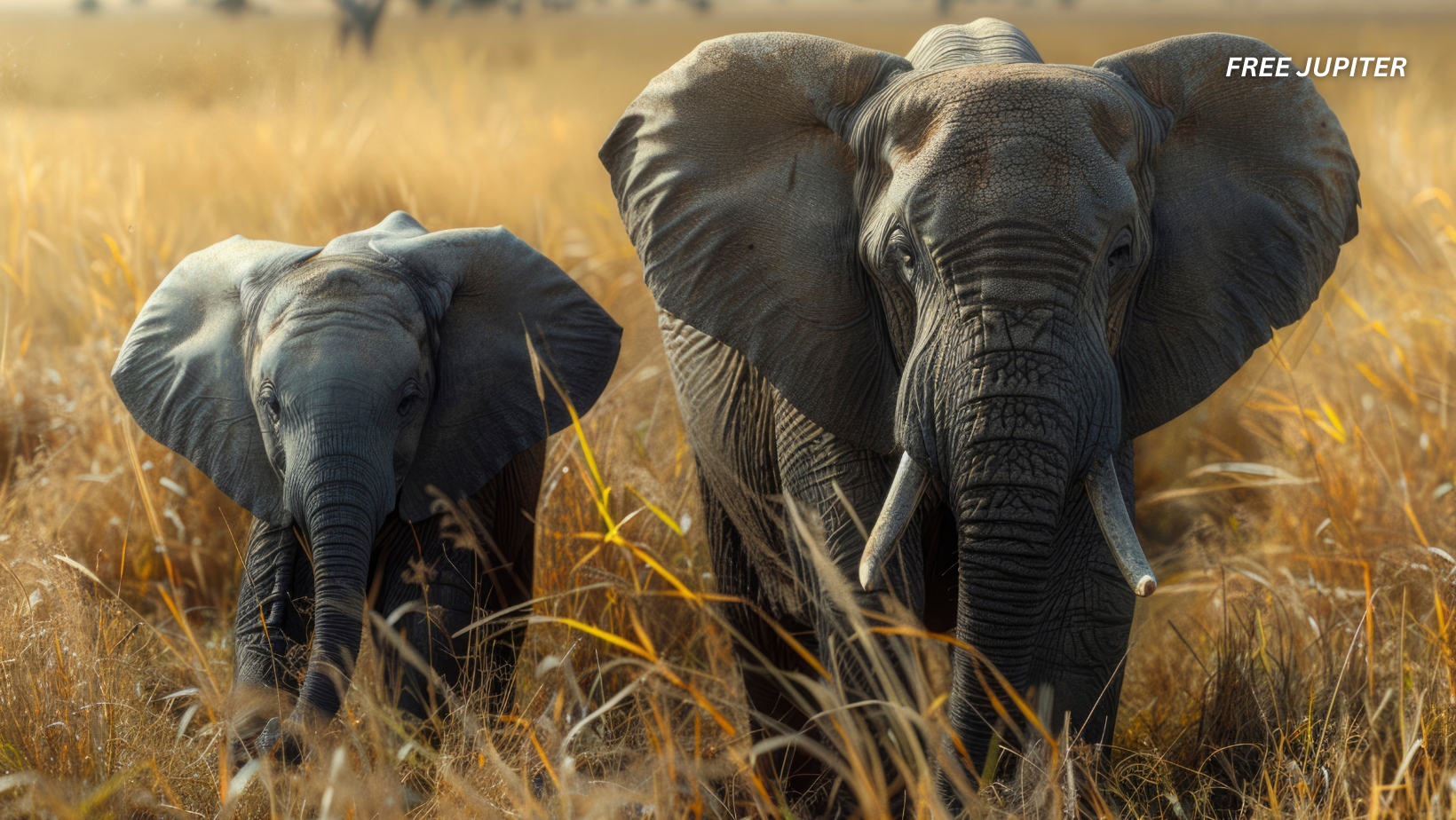Friendly Note: FreeJupiter.com shares general info for curious minds 🌟 Please fact-check all claims—and always check health matters with a professional 💙
We’ve long admired elephants for their intelligence, memory, and emotional depth. They mourn their dead, protect their herd, and even recognize themselves in mirrors—a rare feat in the animal kingdom. But a new wave of research has turned our attention to something even more intriguing: elephants may have been deliberately trying to communicate with us—and they’ve been doing it for quite some time.
That’s right. Elephants aren’t just flapping their ears and swinging their trunks for no reason. According to a new study, they may actually be using these movements—gestures, if you will—with specific intentions, especially when trying to get our attention. And when they don’t get what they want, they try again, sometimes in a new way. In short, they may be talking to us—just not with words.
The Study That Changed Everything
This discovery comes from a team of researchers based primarily at the University of Vienna, with support from the University of St Andrews, the University of Portsmouth, and the City University of New York. The researchers studied semi-captive elephants—that is, elephants living under human care but free to move about—to see how they interact with people when they want something.
The experiment was simple but telling: give the elephants a tray of apples and watch what they do when they want more—or when they don’t get any. What happened was both surprising and strangely relatable. The elephants didn’t just stand around waiting. They actively gestured toward the apples or the humans, signaling that they wanted more. If they only got a partial reward (say, one apple instead of several), they kept gesturing. If they received nothing, they would switch up their gestures—as if trying a different approach to make themselves clearer.
The researchers recorded 38 distinct types of gestures—yes, 38! These weren’t just random movements, either. They were consistent, purposeful, and adapted depending on whether the elephant’s goal was achieved or not. This kind of behavior strongly suggests intentional communication.
Read more: Wildlife Experts Warn: Never Release These 17 Animals Into the Wild
What Does “Intentional Communication” Even Mean?
In humans, intentional communication is second nature. If you want your friend to pass the ketchup, you might glance at the bottle, reach your hand toward it, or simply say, “Can you pass that?” You’re not just reacting—you’re sending a message with a goal in mind.
Researchers wanted to know if elephants do something similar, just without words. To figure this out, they borrowed a framework that’s often used to study how babies learn to communicate. It’s based on three key ideas:
- Audience Awareness (Audience Directedness)
The communicator should only send a signal when there’s someone around to receive it. If the listener isn’t paying attention, a good communicator adjusts—maybe by using touch instead of a visual signal. - Persistence
If the message doesn’t work the first time, the communicator should keep trying. A single swing of the trunk isn’t always enough—sometimes, elephants repeat the same gesture over and over to drive the point home. - Elaboration
If persistence fails, try a different approach. Elephants that didn’t get a response with one gesture would switch it up and try another. This kind of behavior shows not only patience but also creativity.
So, when an elephant reaches its trunk toward a tray of apples, pauses to see if the human reacts, and then tries a different gesture when the apples don’t come—this isn’t just guesswork. It looks a lot like a conversation.
Elephants vs. Apes: Are We Seeing a Pattern?
Until recently, scientists believed that this kind of intentional gesturing was mostly limited to primates—apes, monkeys, and of course, humans. Apes have been observed using over 70 gesture types in the wild, ranging from “Come here” to “Groom me” or “Let’s play.”
But now elephants have entered the conversation—literally. And this is significant because elephants and humans aren’t even close cousins on the evolutionary tree. We last shared a common ancestor with elephants more than 100 million years ago. That means elephants may have developed this kind of communication completely independently. This hints at something profound: that complex, purposeful communication may be more widespread in the animal kingdom than we ever imagined.
Interestingly, a few other non-primate animals have shown signs of intentional gestures too. Certain fish, like guppies, and birds, such as Arabian babblers, have been observed using simple gestures for specific tasks like “follow me.” But elephants are the first non-primates to demonstrate such a broad and adaptable gestural vocabulary—38 different types and counting.
What Do These Elephant Gestures Look Like?
You might be wondering, what does an elephant gesture actually look like? Picture this: one elephant stretches its trunk straight toward a tray of fruit. Another swings its trunk back and forth between the apples and the person standing nearby. One particularly inventive elephant was even seen blowing a leaf into the air, possibly to draw attention.
These aren’t just random movements. They’re deliberate and meaningful, aimed at influencing human behavior. And the elephants don’t just repeat the same gesture mindlessly. If one gesture doesn’t work, they might escalate or shift tactics—just like we might go from asking politely to waving frantically when someone doesn’t hear us.
Read more: Scientists Discover Animals Have a Mysterious ‘Sixth Sense’, Changing Evolutionary Theories
What About Wild Elephants? Are They “Talking” Too?
While this study focused on semi-captive elephants, the researchers—and many others who work with elephants—have observed wild ones behaving in similarly communicative ways. But here’s the catch: in the wild, it’s much harder to prove intentional communication without controlled observations.
Still, early signs are promising. Wild elephants have been seen using trunk swings, touches, and other body language that seem to carry meaning. Some gestures, like reaching out the trunk or touching another elephant gently, may be universal across elephant populations. Others—like the creative “blow leaf” move—might be more individualized, or even culturally specific.
In fact, researchers now wonder whether elephant populations might have their own “dialects” of gestures, much like human languages differ across regions. It’s a question they’re eager to explore.
What’s Next? Mapping the Elephant “Language”
Lead researcher Vesta Eleuteri and her team are now deep into the next phase of their work: decoding the gestural “vocabulary” of wild elephants. They’ve already collected thousands of hours of footage from elephant populations in South Africa and are analyzing every gesture, interaction, and reaction to piece together what the gestures might mean.
This work takes time—painstaking hours of video-coding, cross-referencing, and behavioral analysis. But the goal is exciting: to one day develop a gesture dictionary for elephants. A reference guide that might help us interpret when an elephant is saying “Let’s go,” “Stay back,” or even “Feed me.”
Why This Research Matters Beyond Curiosity
At first glance, this might seem like an academic curiosity—fun facts about elephants for wildlife lovers. But this research has bigger implications.
By showing that elephants have the capacity for intentional, intelligent communication, we’re reinforcing what many already feel deep down: these animals are emotionally complex and socially sophisticated. That matters when we talk about conservation.
If people begin to see elephants not just as animals, but as sentient beings capable of trying to reach us, it may deepen public support for their protection. Recognizing that elephants aren’t just living near us—but are actively trying to connect—could inspire more humane policies and better care, both in the wild and in captivity.
Read more: Chernobyl’s Radioactive Zone Is Creating a New Kind of Dog
Final Thoughts: We’re Finally Learning to Listen
So, the next time you see an elephant reach out with its trunk, pause and wonder: Is it trying to say something? If this study is any indication, the answer might very well be “yes.”
For decades, we’ve assumed that communication with animals was a one-way street. But it turns out, elephants may have been patiently reaching out all along—waiting for us to understand that their silent gestures speak volumes.
And now, thanks to science, we’re starting to listen.










